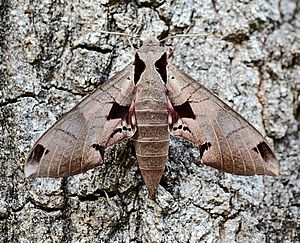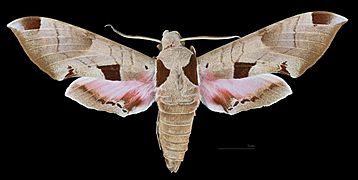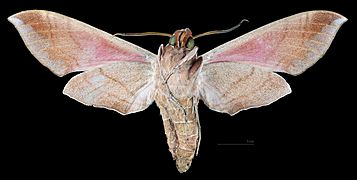Achemon sphinx facts for kids
Quick facts for kids Achemon sphinx |
|
|---|---|
 |
|
| Conservation status | |
| Scientific classification | |
| Genus: |
Eumorpha
|
| Species: |
achemon
|
| Synonyms | |
|
|
The Achemon sphinx (scientific name: Eumorpha achemon) is a type of moth. It belongs to the Sphingidae family. These moths are also known as sphinx moths or hawk moths. Dru Drury first described this species in 1773.
Where Does the Achemon Sphinx Live?
This moth is native to North America. You can find it in most parts of the United States. It also lives in southern Canada and northern Mexico. It is not common in the Pacific Northwest or the Great Basin. It is also rare in the Southern United States, except for Florida.
What Does the Achemon Sphinx Look Like?
The Achemon sphinx moth has a wingspan of about 87 to 97 millimeters. This is roughly the length of a credit card. You can tell it apart from other Eumorpha moths by its hindwings. The upper side of its hindwings is mostly pale pink. This pink color goes from the base of the wing to a dark brown band near the edge.
The young moths, called larvae or caterpillars, come in three main colors. Some are light green. Others are reddish orange. The rest are tan to brown.
How Does the Achemon Sphinx Live?
Adult Achemon sphinx moths fly at different times of the year. In the northern parts of their range, they fly from June to August. This is usually one generation of moths. In the southern areas, they have two generations. Adults there fly from May to August.
Adult moths drink nectar from various flowers. They help pollinate plants like Japanese honeysuckle (Lonicera japonica). They also visit petunias (Petunia × atkinsiana), mock orange (Philadelphus coronarius), and different types of Phlox. This moth is also an important pollinator for a rare orchid called Platanthera praeclara.
The caterpillars (larvae) eat the leaves of certain plants. They are known to feed on Virginia creeper (Parthenocissus quinquefolia). They also eat plants from the Ampelopsis group. You can often find them on wild and farmed Vitaceae plants, which include grapes. Sometimes, they are even found in vineyards, eating grape leaves.




